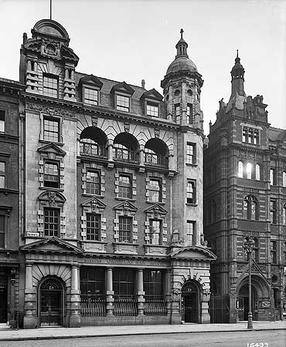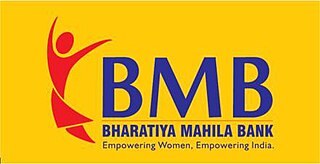
The Delhi and London Bank was a bank that operated in British India.

The Delhi and London Bank was a bank that operated in British India.
It was originally incorporated as the Delhi Banking Corporation in India in 1844 and under this better known name in London in 1865.
The bank separated in 1916 with many of the Indian branches merging into the Alliance Bank of Simla (established in 1874) and the London branch was bought by the Boulton Brothers. The bank was liquidated in 1924 following failure. [1]
The bank is notable for being the twenty-seventh oldest bank in India. [2]

State Bank of India (SBI) is an Indian multinational public sector bank and financial services statutory body headquartered in Mumbai, Maharashtra. SBI is the 48th largest bank in the world by total assets and ranked 221st in the Fortune Global 500 list of the world's biggest corporations of 2020, being the only Indian bank on the list. It is a public sector bank and the largest bank in India with a 23% market share by assets and a 25% share of the total loan and deposits market. It is also the tenth largest employer in India with nearly 250,000 employees. On 14 September 2022, State Bank of India became the third lender and seventh Indian company to cross the ₹ 5-trillion market capitalisation on the Indian stock exchanges for the first time.

Bank of Baroda is an Indian public sector bank headquartered in Vadodara, Gujarat. It is the second largest public sector bank in India after State Bank of India, with 153 million customers, a total business of US$218 billion, and a global presence of 100 overseas offices. Based on 2019 data, it is ranked 1145 on Forbes Global 2000 list.

Punjab National Bank is an Indian public sector bank based in New Delhi. The bank was founded in May 1894 and is the second largest public sector bank in India in terms of its business volumes and second largest in terms of its network. The bank has over 180 million customers, 12,248 branches, and 13,000+ ATMs.
Punjab & Sind Bank is an Indian public sector bank headquartered in New Delhi. As of 18 April 2023, the bank has 1553 branches which are widely spread across India out of which 635 branches are in the state of Punjab, and 25 zonal offices located all over India.
The Chartered Bank of India, Australia and China was a bank incorporated in London in 1853 by Scotsman James Wilson, under a Royal Charter from Queen Victoria.

State Bank of Mysore was a Public Sector bank in India, with headquarters at Bangalore. It was one of the five associate banks of State Bank of India, all of which were consolidated with the State Bank of India with effect from 1 April 2017.
Modern banking in India originated in the mid of 18th century. Among the first banks were the Bank of Hindustan, which was established in 1770 and liquidated in 1829–32; and the General Bank of India, established in 1786 but failed in 1791.

State Bank of Patiala, founded in 1917, was an associate bank of the State Bank Group. It merged with State Bank of India on 1 April 2017. At the time of its merger, State Bank of Patiala had a network of 1445 service outlets, including 1314 branches, in all major cities of India, but most of the branches were located in the Indian states of Punjab, Haryana, Himachal Pradesh, Rajasthan, Jammu & Kashmir, Uttar Pradesh, Madhya Pradesh, Delhi, Gujarat and Maharashtra.

The Bank of Madras was one of the three Presidency Banks of British India, along with the Bank of Bengal and the Bank of Bombay. It was established on 1 July 1843 through the amalgamation of a number of existing regional banks and headquartered in Madras. It was merged with the other Presidency banks in 1921 to form the Imperial Bank of India, which later became the State Bank of India.
Canara Bank is an Indian public sector bank based in Bangalore, India. Established in 1906 at Mangalore by Ammembal Subba Rao Pai. The Bank was nationalized in 1969. Canara bank has offices in London, Dubai and New York also.

The historic overseas bank was established in London in 1828 as Leslie & Grindlay, agents and bankers to the British army and business community in India. Banking operations expanded to include the Indian subcontinent, the Middle East and elements of Africa and Southeast Asia. It was styled Grindlay, Christian & Matthews in 1839, Grindlay & Co from 1843, Grindlay & Co Ltd from 1924 and Grindlays Bank Ltd in 1947 until its merger with the National Bank of India.
Axis Bank Limited, formerly known as UTI Bank (1993–2007), is an Indian banking and financial services company headquartered in Mumbai, Maharashtra. It is India's third largest private sector bank by assets and Fourth largest by Market capitalisation.It sells financial services to large and mid-size companies, SMEs and retail businesses.
The Alliance Bank of Simla was a British-run though India-registered bank that commenced operations in Simla in 1874 under the management of James Lewis Walker. The bank was established to take over the business of the United Bank of India, established in 1866, which had operations in Simla and Umballa. Its board put the United Bank of India in voluntary liquidation on 21 March 1874, and Alliance Bank commenced operations two days later. After 49 years, Alliance Bank failed on 27 April 1923 due to speculation by its management. At the time that it failed it had 36 branches, including ones in Lahore, Lucknow, Peshawar, Rawalpindi, and Rangoon.

The Oriental Bank Corporation, or "OBC", was a British imperial bank founded in India in 1842 which grew to be prominent throughout the Far East. As an Exchange bank, the OBC was primarily concerned with the finance of trade and exchanges of different currencies. It was the first bank in Hong Kong and the first bank to issue banknotes in Hong Kong.

Sir Henry Seymour King, 1st Baronet KCIE was a British banker, mountaineer and Conservative politician.

The Nainital Bank Limited (NTB) is a scheduled commercial bank founded in 1922. The bank is a subsidiary of Bank of Baroda which is under the ownership of Ministry of Finance of the Government of India. The bank has expanded to Uttar Pradesh and Uttarakhand, and has only 170 branches in Rajasthan, Delhi and Haryana.

Bharatiya Mahila Bank was a fully owned subsidiary of State Bank of India based in Mumbai, India. Former Indian Prime Minister Manmohan Singh inaugurated the system on 19 November 2013 on the occasion of the 96th birth anniversary of former Indian Prime Minister Indira Gandhi. As part of the Modi government's banking reforms and to ensure greater banking outreach to women, the bank merged with State Bank of India on 1 April 2017.
Lakshmi Vilas Bank was an Indian private sector bank established in 1926 in Karur, Tamil Nadu. As of November 2020, the bank had 566 branches in 19 states and 1 union territory. On 27 November 2020, the bank was merged into the Indian subsidiary of DBS Bank.
The Government Savings Bank (1833) was a bank founded in the year 1833 in British India. The bank was the fifteenth oldest bank in India.